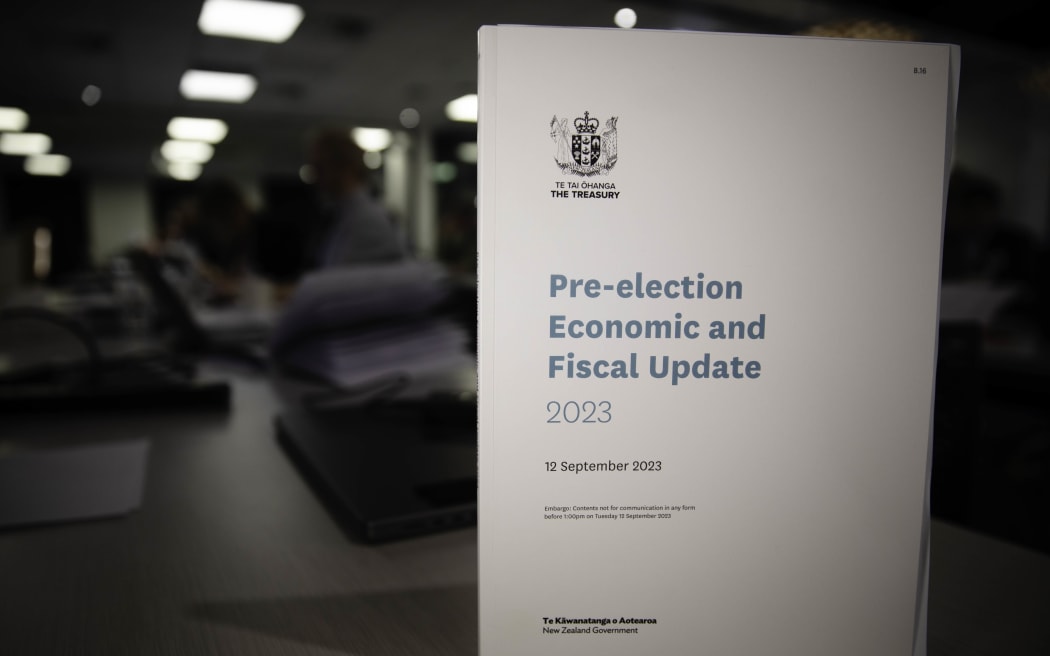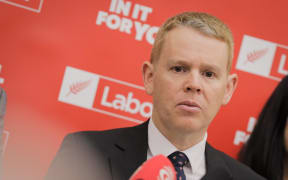
Finance Minister Grant Robertson speaking at the briefing Photo: RNZ / Angus Dreaver
The economic outlook and government books are in slightly better than expected shape, but still face a challenging couple of years, according to pre-election forecasts issued by the Treasury.
The Pre-Election Economic and Fiscal Update (PREFU) showed the expected deficit for the 2022/23 year ballooned to $11.4 billion from the previous forecast $7.6b as the tax take fell $2.9b short of forecasts.
Deficits for the next two years have been increased as expenses outpace the growth in revenue, with a return to surplus now delayed another year until 2026/27.
Key economic numbers (for year ended June 2024 vs May budget forecasts)
- * GDP (annual) 1.3 pct vs 1.0 pct
- * Inflation 3.8 pct vs 3.3 pct
- * Unemployment 4.8 pct vs 5.0 pct
- * Current acct -6.6 pct/GDP vs -5.9 pct
Key fiscal numbers (for year ended June 2024 vs May budget forecasts)
- Core tax revenue $121.6b vs $123.2b
- Core expenses $139.4b vs $137.0b
- OBEGAL (budget balance) -$11.4 vs -$7.6b
- Net debt (pct GDP) 22.3 vs 22.0
- Govt net bond issue to 2027 $49.3b vs $39.4b
Minister of Finance Grant Robertson said the New Zealand economy has remained strong in the face of slower local and global economic conditions, high inflation, and was at a turning point with future growth forecast.
"The economy is holding its own in an uncertain global environment."
Treasury forecasts showed New Zealand would avoid recession, with wages keeping ahead of inflation, high employment, he said.
The Treasury short-term forecasts were based on inflation proving to be more stubborn than originally expected, interest rates staying higher for longer, and a quicker than expected turnaround in the housing market.
It also expected the recent surge in migration, forecast to reach 100,000 this year, to provide a cushion to the downturn in other sectors.
Robertson said the relatively positive outlook reflected Labour's policies.
"Our economic plan to support New Zealanders dealing with the cost of living while investing in building a stronger, more resilient and inclusive economy is working."
Labour leader Chris Hipkins said overall he was "pretty pleased with the picture" the PREFU showed, which was that New Zealand's economy was turning the corner after a rough period of time.
"Economic growth is returning, the government's bookings are heading back into surplus and we're winning the battle against inflation," he said.
"The forecasts are showing that unemployment will remain low and there is real reason for optimism about the future of the New Zealand economy and I think the pre-election fiscal update shows that."

The PREFU showed the expected deficit for the 2022/23 year ballooned to $11.4 billion from the previous forecast $7.6b. Photo: RNZ / Angus Dreaver
The main view
Economic growth forecasts were slightly more upbeat than in the May budget, with an expectation of subdued growth over the coming year, while inflation was forecast to be slower to reduce as the Reserve Bank's cash rate rises of the past 18 months continues to work through the economy.
The Treasury forecasts said unemployment was on the point of heading higher from current near record low levels of 3.6 percent to a peak of 5.4 percent in 2025.
The tax forecasts were reduced as a slower economy and higher unemployment crimped returns, with the growth in receipts nearly $4.0b less than in the May budget.
At the same time expenses were forecast to be $6.7b higher over the next four years.
The result was bigger deficits over the next four years, peaking this year at $11.4b, before declining to a later than expected surplus of $2.1b in 2026/27.
Government borrowing was expected to increase by $9b to $129b over the next four years, which would also cover maturing bonds and buyback the bonds acquired by the Reserve Bank during the pandemic.
Net debt was forecast to peak at 22.8 percent of GDP in 2025 before declining to 21.0 percent in 2027.
Robertson said the government's fiscal management had passed the scrutiny of the main global ratings agencies, all of which had reaffirmed the country's top level ratings in the past month.
However, in the current environment it was necessary to "cut our cloth" and take a balanced and responsible approach, but the public could feel "comfortable" with the state of the government's finances, he said.
For better, for worse
In addition to its main forecast scenario, the Treasury looked at possible effects of a better than expected outlook, and a more pessimistic view.
The more positive outlook expected stronger growth in the short term, slightly higher inflation caused by stronger growth, interest rates staying higher for longer, a lower peak in unemployment, but lower government debt, and smaller deficits and a quicker return to budget surplus.
The more downbeat scenario pointed to slower growth, little change in inflation, higher unemployment, and a slower return to budget surplus.
Follow all the developments on the election trail with RNZ's blog







